Internal Iliac Artery Ligation in Obstetrics and Gynecology: Surgical Anatomy and Surgical Considerations
Abstract
:1. Introduction
2. Methodology
3. Internal Iliac Artery Anatomy
3.1. Level of the IIA Origin
3.2. Level of Termination of IIA Trunks
3.3. Length of IIA
3.4. Variability in the Branching Pattern of the IIA
4. Indications for IIA Ligation
- Ruptured ectopic non-tubal pregnancy (cervical, interstitial, or in the peritoneum in the rectouterine pouch);
- Severe cervical or uterine injury during surgical abortion;
- Uterine rupture before or during delivery;
- Severe obstetrical lacerations (with or without instrumental delivery) extending to the uterine cervix or parametrium;
- Placenta previa;
- Placental abruption;
- Placenta accreta spectrum;
- Postpartal retroperitoneal hematoma.
- Uncontrollable hemorrhage from advanced uterine, vaginal, or vulvar cancer;
- Prophylactic ligation during oncogynecological procedures with expected profuse bleeding (e.g., pelvic exenteration);
- Pelvic hemorrhage or massive retroperitoneal hematoma due to iatrogenic (e.g., trocar insertion) or traumatic (gunshot or fracture) injury;
- Massive pelvic hemorrhage or retroperitoneal pelvic hematoma due to primary or secondary coagulation disorders (e.g., with no visible bleeding);
- Actual or possible hemorrhage in patients who refuse blood transfusion (e.g., Jehovah’s Witnesses).
5. Why Is Internal Iliac Artery Ligation Still a Viable Option?
- Specialized equipment and expertise are prerequisites.
- They are less effective in traumatic patients or instances of unforeseen bleeding.
- Patients must be hemodynamically stable without coagulation disorders.
- The procedures typically require at least one hour.
- Access to the radiology department may necessitate relocating to another building.
- SAE or TBO procedures are infrequently performed in low- or middle-income countries.
- SAE has specific contraindications, including uterine rupture and eversion (which should be managed surgically), arterial anomalies, coagulopathy, impaired renal function, and contrast material allergies.
6. Surgical Technique of IIA Ligation
- -
- As mentioned earlier, the origin of the IIA is typically found at the level of the promontory.
- -
- Visualize an imaginary bony line that passes through both anterior superior iliac spines.
7. Perioperative Complications
8. Hemodynamics after IIA Ligation
9. Anastomoses in the Pelvis and Their Relation to IIA Ligation
10. Fertility and Pregnancy Outcomes following IIA Ligation
11. Recommendations
12. Conclusions
Author Contributions
Funding
Institutional Review Board Statement
Informed Consent Statement
Data Availability Statement
Acknowledgments
Conflicts of Interest
References
- Gray, H.; Standring, S.; Hrold Ellis, H.; Berkovitz, B. Gray’s Anatomy: The Anatomical Basis of Clinical Practice, 39th ed.; Elsevier Churchill Livingstone Edinburgh: New York, NY, USA, 2005. [Google Scholar]
- Chitragari, G.; Schlosser, F.J.; Ochoa Chaar, C.I.; Sumpio, B.E. Consequences of hypogastric artery ligation, embolization, or coverage. J. Vasc. Surg. 2015, 62, 1340–1347.e1. [Google Scholar] [CrossRef] [PubMed]
- Sanders, A.P.; Hobson, S.R.; Kobylianskii, A.; Smith, J.P.; Allen, L.; Windrim, R.; Kingdom, J.; Murji, A. Internal iliac artery ligation-a contemporary simplified approach. Am. J. Obstet. Gynecol. 2021, 225, 339–340. [Google Scholar] [CrossRef] [PubMed]
- Kelly, H. Ligation of both internal iliac arteries for hemorrhage in hysterectomy for carcinoma uteri. Bull. John Hopkins Hosp. 1894, 5, 53. [Google Scholar]
- Nieto-Calvache, A.J.; Palacios-Jaraquemada, J.M.; Aryananda, R.A.; Basanta, N.; Burgos-Luna, J.M.; Rodriguez, F.; Ordoñez, C.; Sarria-Ortiz, D.; Muñoz-Córdoba, L.; Quintero, J.C.; et al. Ligation or Occlusionof the Internal Iliac Arteries for the Treatment of Placenta Accreta Spectrum: Why IsThis Technique Still Performed? Maternal Fetal. Med. 2023, 5, 131–136. [Google Scholar] [CrossRef]
- Sziller, I.; Hupuczi, P.; Papp, Z. Hypogastric artery ligation for severe hemorrhage in obstetric patients. J. Perinat. Med. 2007, 35, 187–192. [Google Scholar] [CrossRef]
- Papp, Z.; Tóth-Pál, E.; Papp, C.; Sziller, I.; Gávai, M.; Silhavy, M.; Hupuczi, P. Hypogastric artery ligation for intractable pelvic hemorrhage. Int. J. Gynaecol. Obstet. 2006, 92, 27–31. [Google Scholar] [CrossRef]
- Field, K.; Ryan, M.J.; A Saadeh, F.; Kamran, W.; Brennan, V.; Gillham, C.; Gleeson, N. Selective arterial embolisation for intractable vaginal haemorrhage in genital tract malignancies. Eur. J. Gynaecol. Oncol. 2016, 37, 736–740. [Google Scholar]
- Takeda, J.; Makino, S. Temporary Arterial Balloon Occlusion for Obstetrical Field. In Gynecologic and Obstetric Prophylactic Hemostasis by Intra-arterial Balloon Occlusion; Takeda, S., Kuwatsuru, R., Eds.; Springer: Singapore, 2018; pp. 33–39. [Google Scholar]
- Nizard, J.; Barrinque, L.; Frydman, R.; Fernandez, H. Fertility and pregnancy outcomes following hypogastric artery ligation for severe post-partum haemorrhage. Hum. Reprod. 2003, 18, 844–848. [Google Scholar] [CrossRef]
- B-Lynch, C.; Keith, L.G.; Campbell, W.B. Internal iliac (hypogastric) artery ligation. In A Textbook of Postpartum Hemorrhage A Comprehensive Guide to Evaluation, Management and Surgical Intervention, 1st ed.; B-Lynch, C., Keith, L.G., Lalonde, A.B., Karosmi, M., Eds.; Sapiens Publishing: London, UK, 2006; pp. 299–307. [Google Scholar]
- Tubbs, R.S.; Shoja, M.M.; Loukas, M. Bergman’s Comprehensive Encyclopedia of Human Anatomic Variation; John Wiley & Sons: Hoboken, NJ, USA, 2016; pp. 669–673, 884–889. [Google Scholar]
- Shafiroff, B.G.P.; Grillo, E.B.; Baron, H. Bilateral ligation of the hypogastric arteries. Am. J. Surg. 1959, 98, 34–40. [Google Scholar] [CrossRef]
- Naveen, N.S. Morphological Analysis of the Human Internal Iliac Artery in South Indian Population. Online J. Health Allied. Sci. 2011, 10, 1–4. [Google Scholar]
- Mamatha, H.; Hemalatha, B.; Vinodini, P.; Souza, A.S.; Suhani, S. Anatomical Study on the Variations in the Branching Pattern of Internal Iliac Artery. Indian J. Surg. 2015, 77 (Suppl. S2), 248–252. [Google Scholar] [CrossRef] [PubMed]
- Sakthivelavan, S.; Aristotle, S.; Sivanandan, A.; Sendiladibban, S.; Felicia Jebakani, C. Variability in the branching pattern of the internal iliac artery in Indian population and its clinical importance. Anat. Res. Int. 2014, 2014, 597103. [Google Scholar] [CrossRef] [PubMed]
- Selçuk, İ.; Yassa, M.; Tatar, İ.; Huri, E. Anatomic structure of the internal iliac artery and its educative dissection for peripartum and pelvic hemorrhage. Turk. J. Obstet. Gynecol. 2018, 15, 126–129. [Google Scholar] [CrossRef] [PubMed]
- Bleich, A.T.; Rahn, D.D.; Wieslander, C.K.; Wai, C.Y.; Roshanravan, S.M.; Corton, M.M. Posterior division of the internal iliac artery: Anatomic variations and clinical applications. Am. J. Obstet. Gynecol. 2007, 197, 658.e1–658.e5. [Google Scholar] [CrossRef] [PubMed]
- Adachi, B. Das arteriensystem der Japaner. Band 1928, 9, 1926–1927. [Google Scholar]
- Fătu, C.; Puişoru, M.; Fătu, I.C. Morphometry of the internal iliac artery in different ethnic groups. Ann. Anat. 2006, 188, 541–546. [Google Scholar] [CrossRef] [PubMed]
- Yuvaraj, M.F.; Balaji, T.; Rajila, R.H.S.; Vaithianathan, G.; Aruna, S.; Balaji, K. Study on Variations in the Origin and Branching Pattern of Internal Iliac Artery in Cadavers. Biomed Pharmacol. J. 2018, 11, 2201–2207. [Google Scholar]
- Standring, S. Gray’s Anatomy, 42nd ed.; The Anatomical Basis of Clinical Practice; Elsevier: Amsterdam, The Netherlands, 2020; Chapter 71; pp. 1248–1249. [Google Scholar]
- de Treigny, O.M.; Roumiguie, M.; Deudon, R.; de Bonnecaze, G.; Carfagna, L.; Chaynes, P.; Rimailho, J.; Chantalat, E. Anatomical study of the inferior vesical artery: Is it specific to the male sex? Surg. Radiol. Anat. 2017, 39, 961–965. [Google Scholar] [CrossRef]
- Bekavac, I.; Kupesic, S.; Mihaljevic, D.; Kurjak, A. Vascular impedance of uterine, inferior vesicle, and ophthalmic arteries in postmenopausal women receiving hormonal replacement therapy: Comparative Doppler study. Croat Med. J. 2000, 41, 235–239. [Google Scholar]
- Ercoli, A.; Delmas, V.; Fanfani, F.; Gadonneix, P.; Ceccaroni, M.; Fagotti, A.; Mancuso, S.; Scambia, G. Terminologia Anatomica versus unofficial descriptions and nomenclature of the fasciae and ligaments of the female pelvis: A dissection-based comparative study. Am. J. Obstet. Gynecol. 2005, 193, 1565–1573. [Google Scholar] [CrossRef]
- Muallem, M.Z.; Armbrust, R.; Neymeyer, J.; Miranda, A.; Muallem, J. Nerve Sparing Radical Hysterectomy: Short-Term Oncologic, Surgical, and Functional Outcomes. Cancers 2020, 12, 483. [Google Scholar] [CrossRef] [PubMed]
- Holub, Z.; Lukac, J.; Kliment, L.; Urbanek, S. Variability of the origin of the uterine artery: Laparoscopic surgical observation. J. Obstet. Gynaecol. Res. 2005, 31, 158–163. [Google Scholar] [CrossRef] [PubMed]
- Khan, R.; Naidoo, N.; Lazarus, L. Unique vascular patterns of the internal iliac artery and its clinical import in pelvic surgery. Transl. Res. Anat. 2021, 25, 100151. [Google Scholar] [CrossRef]
- Mohammadbaigi, H.; Darvishi, M.; Moayeri, A. Variations of anterior and posterior division of internal iliac artery: A systematic review and clinical implications. Biomed Res. Ther. 2019, 6, 3189–3206. [Google Scholar] [CrossRef]
- Siedhoff, M.T.; Gubernick, L.; Ronen, I.; Wright, K.N. Internal Iliac Artery Ligation in Laparoscopic Myomectomy. J. Minim. Invasive Gynecol. 2019, 26 (Suppl. S7), S1. [Google Scholar] [CrossRef]
- Singh, A.; Kishore, R.; Saxena, S.S. Ligating Internal Iliac Artery: Success beyond Hesitation. J. Obstet. Gynaecol. India 2016, 66 (Suppl. S1), 235–241. [Google Scholar] [CrossRef]
- Darawade, S.P.; Wagle, A.A.; Trivedi, S.; Manwani, S. Bilateral internal iliac artery ligation: The procedure of choice in life threatening postpartum haemorrhage. Int. J. Reprod Contracept. Obstet. Gynecol. 2020, 9, 3607–3611. [Google Scholar] [CrossRef]
- Watrowski, R.; Jäger, C.; Forster, J. Improvement of Perioperative Outcomes in Major Gynecological and Gynecologic-Oncological Surgery with Hemostatic Gelatin-Thrombin Matrix. In Vivo 2017, 31, 251–258. [Google Scholar] [CrossRef]
- Papp, Z.; Sztanyik, L.; Szabó, I.; Inovay, J. Successful pregnancy after bilateral internal iliac artery ligation monitored by color Doppler imaging. Ultrasound Obstet Gynecol. 1996, 7, 211–212. [Google Scholar] [CrossRef]
- Rand, T.; Patel, R.; Magerle, W.; Uberoi, R. CIRSE standards of practice on gynaecological and obstetric haemorrhage. CVIR Endovasc. 2020, 3, 85. [Google Scholar] [CrossRef]
- Escobar, M.F.; Nassar, A.H.; Theron, G.; Barnea, E.R.; Nicholson, W.; Ramasauskaite, D.; Lloyd, I.; Chandraharan, E.; Miller, S.; Burke, T.; et al. FIGO recommendations on the management of postpartum hemorrhage 2022. Int. J. Gynecol. Obstet. 2022, 157 (Suppl. S1), 3–50. [Google Scholar] [CrossRef] [PubMed]
- Bakay, K.; Yavuzcan, A.; Kalkan, Ü.; Yalcin, I.; Hatırnaz, S.; Başbuğ, A.; Güven, D. Hypogastric artery ligation in laparoscopic hysterectomy: Results from a randomized controlled trial. Clin. Exp. Obstet. Gynecol. 2021, 48, 1304–1310. [Google Scholar] [CrossRef]
- Kuriya, A.; Scattolon, S.; Leyland, N. The Use of Laparoscopic Internal Iliac Artery Ligation in Morbidly Adherent Placenta. J. Minim. Invasive Gynecol. 2017, 24, S123. [Google Scholar] [CrossRef]
- Xu, W.; Wang, M.; Li, J.; Lin, X.; Wu, W.; Yang, J. Laparoscopic combined hysteroscopic management of cesarean scar pregnancy with temporary occlusion of bilateral internal iliac arteries: A retrospective cohort study. Medicine 2019, 98, e17161. [Google Scholar] [CrossRef] [PubMed]
- Balulescu, L.; Nistor, S.; Lungeanu, D.; Brasoveanu, S.; Pirtea, M.; Secosan, C.; Grigoras, D.; Caprariu, R.; Pasquini, A.; Pirtea, L. Minimizing blood loss in laparoscopic myomectomy with temporary occlusion of the hypogastric artery. Front. Med. 2023, 10, 1216455. [Google Scholar] [CrossRef] [PubMed]
- Multescu, R.; Geiorgescu, D.; Geavlete, P.A.; Geavlete, B. Notions of Histology, Anatomy, and Physiolohy of the Upper Urinary Tract. In Geavlete PA eddits Retrograde Ureteroscopy: Handbook of Endourology; Academic Press: Cambridge, MA, USA, 2016; pp. 7–19. [Google Scholar]
- Wedel, T. Topographical Anatomy for Hysterectomy Procedures. In Ibrahim Alkatout Liselotte Mettler. Hysterectomy A Comprehensive Surgical Approach; Springer: Cham, Switzerland, 2018; pp. 37–60. [Google Scholar]
- Kostov, S.; Slavchev, S.; Dzhenkov, D.; Mitev, D.; Yordanov, A. Avascular Spaces of the Female Pelvis-Clinical Applications in Obstetrics and Gynecology. J. Clin. Med. 2020, 9, 1460. [Google Scholar] [CrossRef]
- Nabhan, A.E.; AbdelQadir, Y.H.; Abdelghafar, Y.A.; Kashbour, M.O.; Salem, N.; Abdelkhalek, A.N.; Nourelden, A.Z.; Eshag, M.M.E.; Shah, J. Therapeutic effect of Internal iliac artery ligation and uterine artery ligation techniques for bleeding control in placenta accreta spectrum patients: A meta-analysis of 795 patients. Front. Surg. 2022, 9, 983297. [Google Scholar] [CrossRef]
- Raba, G. Small invasive technique of Internal Iliac Artery ligation for postpartum haemorrhage. Ginekol. Pol. 2020, 91, 29–31. [Google Scholar] [CrossRef]
- Selçuk, İ.; Uzuner, B.; Boduç, E.; Baykuş, Y.; Akar, B.; Güngör, T. Step-by-step ligation of the internal iliac artery. J. Turk. Ger. Gynecol. Assoc. 2019, 20, 123–128. [Google Scholar] [CrossRef]
- Choi, K.; Keum, M.A.; Choi, B.; Noh, M.; Choi, S.; Kyoung, K.-H.; Kim, S.; Hong, E.S.; Kim, J.T. Effectiveness and safety of bilateral internal iliac artery ligation with pre-peritoneal pelvic packing for life-threatening pelvic trauma. Injury 2023, 54, 598–603. [Google Scholar] [CrossRef]
- Padumadasa, S. Internal iliac artery ligation—Time to revive a dying art. Sri Lanka J. Obstet. Gynaecol. 2020, 42, 42–52. [Google Scholar] [CrossRef]
- Sadahiro, S.; Ishida, H.; Suzuki, T.; Ishikawa, K.; Tajima, T.; Makuuchi, H. Vesicular blood flow after ligation of the internal iliac arteries in low anterior resection or abdominoperineal resection. Dis. Colon Rectum. 1999, 42, 1475–1479. [Google Scholar] [CrossRef] [PubMed]
- Andriole, G.L.; Sugarbaker, P.H. Perineal and bladder necrosis following bilateral internal iliac artery ligation. Report of a case. Dis. Colon Rectum. 1985, 28, 183–184. [Google Scholar] [CrossRef] [PubMed]
- Bangal, V.; Kwatra, A.; Raghav, S. Role of internal iliac artery ligation in control of pelvic hemorrhage. Pravara Med. Rev. 2009, 1, 23–25. [Google Scholar]
- Gezer, Ş.; Çakır, Ö. Lumbosacral neuropathy and buttock necrosis after internal iliac arterial embolization in abundant bleeding cervical carcinoma. Eur. J. Gynaecol. Oncol. 2019, 40, 867–869. [Google Scholar]
- Picone, A.L.; Green, R.M.; Ricotta, J.R.; May, A.G.; DeWeese, J.A. Spinal cord ischemia following operations on the abdominal aorta. J. Vasc. Surg. 1986, 3, 95–103. [Google Scholar] [CrossRef]
- Asgari, M.A.; Masoumi, N.; Argani, H. Gluteal Necrosis and Lumbosacral Plexopathy in a Diabetic Patient after Renal Transplantation. Case Rep. Urol. 2015, 2015, 976912. [Google Scholar] [CrossRef]
- Travis, T.; Monsky, W.L.; London, J.; Danielson, M.; Brock, J.; Wegelin, J.; Link, D.P. Evaluation of short-term and long-term complications after emergent internal iliac artery embolization in patients with pelvic trauma. J. Vasc. Interv. Radiol. 2008, 19, 840–847. [Google Scholar] [CrossRef]
- Shin, R.K.; Stecker, M.M.; Imbesi, S.G. Peripheral nerve ischaemia after internal iliac artery ligation. J. Neurol. Neurosurg. Psychiatry 2001, 70, 411–412. [Google Scholar] [CrossRef]
- Washington, S.; Osterberg, E.C.; Elliott, S.P.; Hittelman, A.B.; Breyer, B.N. Acute Bladder Necrosis after Pelvic Arterial Embolization for Pelvic Trauma: Lessons Learned from Two Cases of Immediate Postembolization Bladder Necrosis. Case Rep. Urol. 2016, 2016, 7594192. [Google Scholar] [CrossRef]
- Ali, A.; Nabi, G.; Swami, S.; Somani, B. Bladder necrosis secondary to internal iliac artery embolization following pelvic fracture. Urol. Ann. 2014, 6, 166–168. [Google Scholar] [CrossRef] [PubMed]
- Burchell, R.C.; Olson, G. Internal iliac artery ligation: Aortograms. Obstet. Gynecol. 1966, 94, 117–124. [Google Scholar] [CrossRef] [PubMed]
- Raba, G.; Baran, P. Hemodynamic parameters following bilateral internal iliac arteries ligation as a treatment of intrapartum hemorrhage. Ginekol. Pol. 2009, 80, 179–183. [Google Scholar]
- Burchell, R.C.; Mengert, W.F. Internal iliac artery ligation: A series of 200 patients. J. Int. Fed. Obstet. Gynecol. 1969, 7, 85. [Google Scholar] [CrossRef]
- Akinwande, O.; Ahmad, A.; Ahmad, S.; Coldwell, D. Review of pelvic collateral pathways in aorto-iliac occlusive disease: Demonstration by CT angiography. Acta Radiol. 2015, 56, 419–427. [Google Scholar] [CrossRef] [PubMed]
- Fredet, P. Quelques Recherches sur les Arteres de L’uterus; Journal de l’Anatomi et de la Physiologie: Berlin, Germany, 1899; p. 79. [Google Scholar]
- Kristek, J.; Kachlik, D.; Sticova, E.; Fronek, J. Contralateral and Ipsilateral Arterial Vasculature of the Human Uterus: The Pilot Results of an Anatomical Study. Physiol. Res. 2022, 71 (Suppl. S1), S89–S97. [Google Scholar] [CrossRef] [PubMed]
- Fröber, R. Surgical anatomy of the ureter. BJU Int. 2007, 100, 949–965. [Google Scholar] [CrossRef]
- Pelage, J.P.; Le Dref, O.; Soyer, P.; Jacob, D.; Kardache, M.; Dahan, H.; Lassau, J.P.; Rymer, R. Arterial anatomy of the female genital tract: Variations and relevance to transcatheter embolization of the uterus. AJR Am. J. Roentgenol. 1999, 172, 989–994. [Google Scholar] [CrossRef]
- Lanciego, C.; Diaz-Plaza, I.; Ciampi, J.J.; Cuena-Boy, R.; Rodríguez-Martín, N.; Maldonado, M.D.; Rodriguez-Gómez, O.; Cañete, M.L.; García-García, L. Utero-ovarian anastomoses and their influence on uterine fibroid embolization. J. Vasc. Interv. Radiol. 2012, 23, 595–601. [Google Scholar] [CrossRef]
- Kostov, S.; Slavchev, S.; Dzhenkov, D.; Stoyanov, G.; Dimitrov, N.; Yordanov, A.D. Corona mortis, aberrant obturator vessels, accessory obturator vessels: Clinical applications in gynaecology. Folia Morphol. 2021, 80, 776–785. [Google Scholar] [CrossRef]
- Marvanova, Z.; Kachlik, D. The anatomical variability of obturator vessels: Systematic review of literature. Ann. Anat. 2024, 251, 152167. [Google Scholar] [CrossRef] [PubMed]
- Selçuk, İ.; Ersak, B.; Tatar, İ.; Güngör, T.; Huri, E. Basic clinical retroperitoneal anatomy for pelvic surgeons. Turk. J. Obstet. Gynecol. 2018, 15, 259–269. [Google Scholar] [CrossRef] [PubMed]
- Braithwaite, J.L. The arterial supply of the male urinary bladder. Br. J. Urol. 1952, 24, 64. [Google Scholar]
- Shehata, R. The arterial supply of the urinary bladder. Acta Anat. 1976, 96, 128–134. [Google Scholar] [CrossRef] [PubMed]
- Kaya, B.; Damarer, Z.; Daglar, K.; Unal, O.; Soliman, A.; Guralp, O. Is there yet a role for internal iliac artery ligation in obstetric hemorrhage with the current gain in popularity of other uterus sparing techniques? J. Matern. Fetal Neonatal Med. 2017, 30, 1325–1332. [Google Scholar] [CrossRef] [PubMed]
- Martyn, P.; Loewenau-Samusionek, K.; Waśniewski, T.; Lipińska, J. Subsequent pregnancy following B-Lynch suture, bilateral ligation of uterine arteries, utero-ovarian arteries and internal iliac arteries due to uterine atony—A case report. Pol. Ann. Med. 2013, 20, 124–127. [Google Scholar] [CrossRef]
- Elmorsey, A.S.; Nasr, M.G.; Megahed, A.M. Combined Internal Iliac Artery Ligation, Transverse B-Lynch Suture and Intrauterine Balloon to Control Bleeding from Placenta Previa Accreta during Caesarean Section. EJMS 2022, 1, 26–31. [Google Scholar]
- İçen, M.S.; Findik, F.M.; Akin Evsen, G.; Ağaçayak, E.; Yaman Tunç, S.; Evsen, M.S.; Gül, T. Hypogastric artery ligation in postpartum haemorrhage: A ten-year experience at a tertiary care centre. J. Obstet. Gynaecol. 2021, 41, 536–540. [Google Scholar] [CrossRef]
- Domingo, S.; Perales-Puchalt, A.; Soler, I.; Marcos, B.; Tamarit, G.; Pellicer, A. Clinical outcome, fertility and uterine artery Doppler scans in women with obstetric bilateral internal iliac artery ligation or embolisation. J. Obstet. Gynaecol. 2013, 33, 701–704. [Google Scholar] [CrossRef]
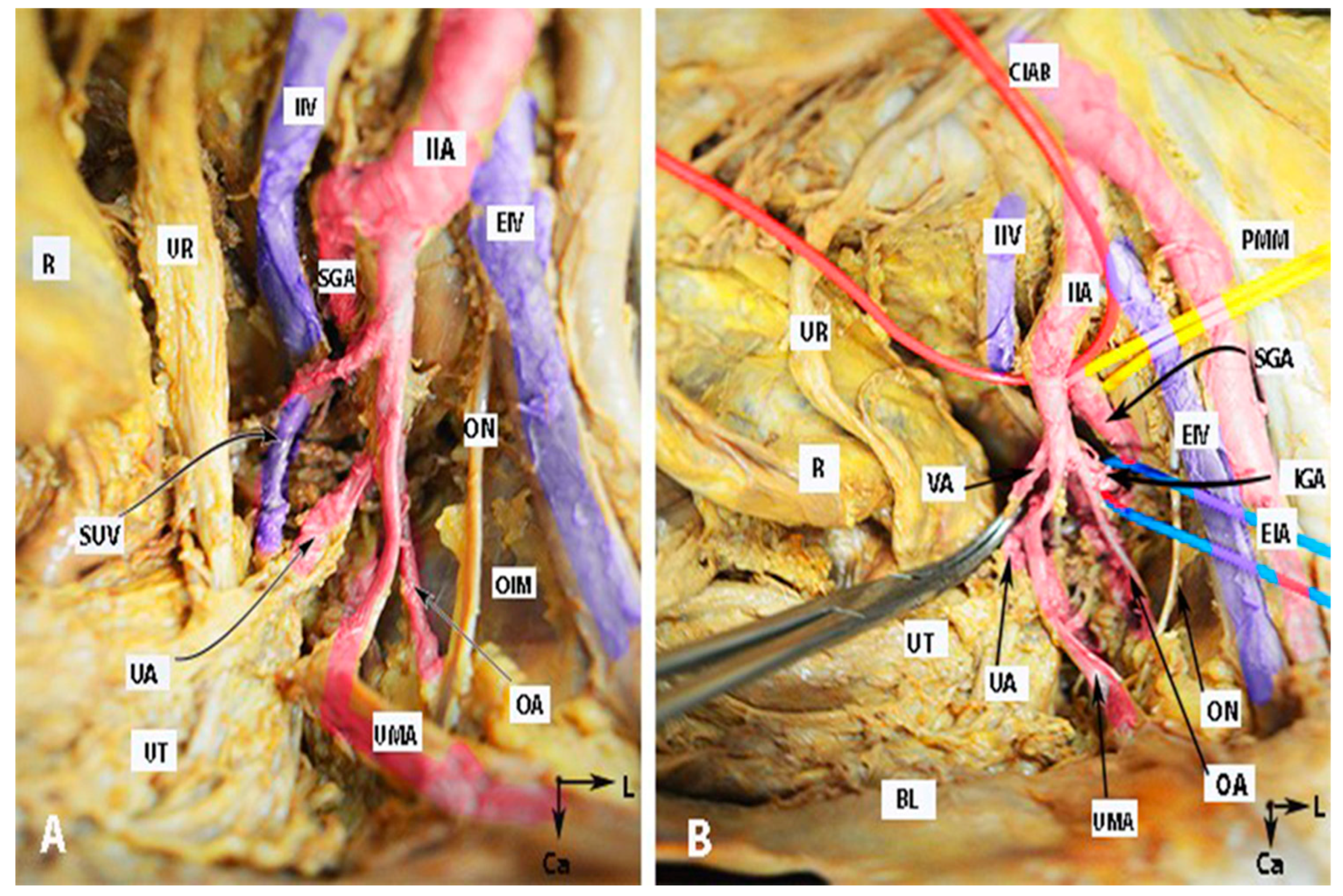
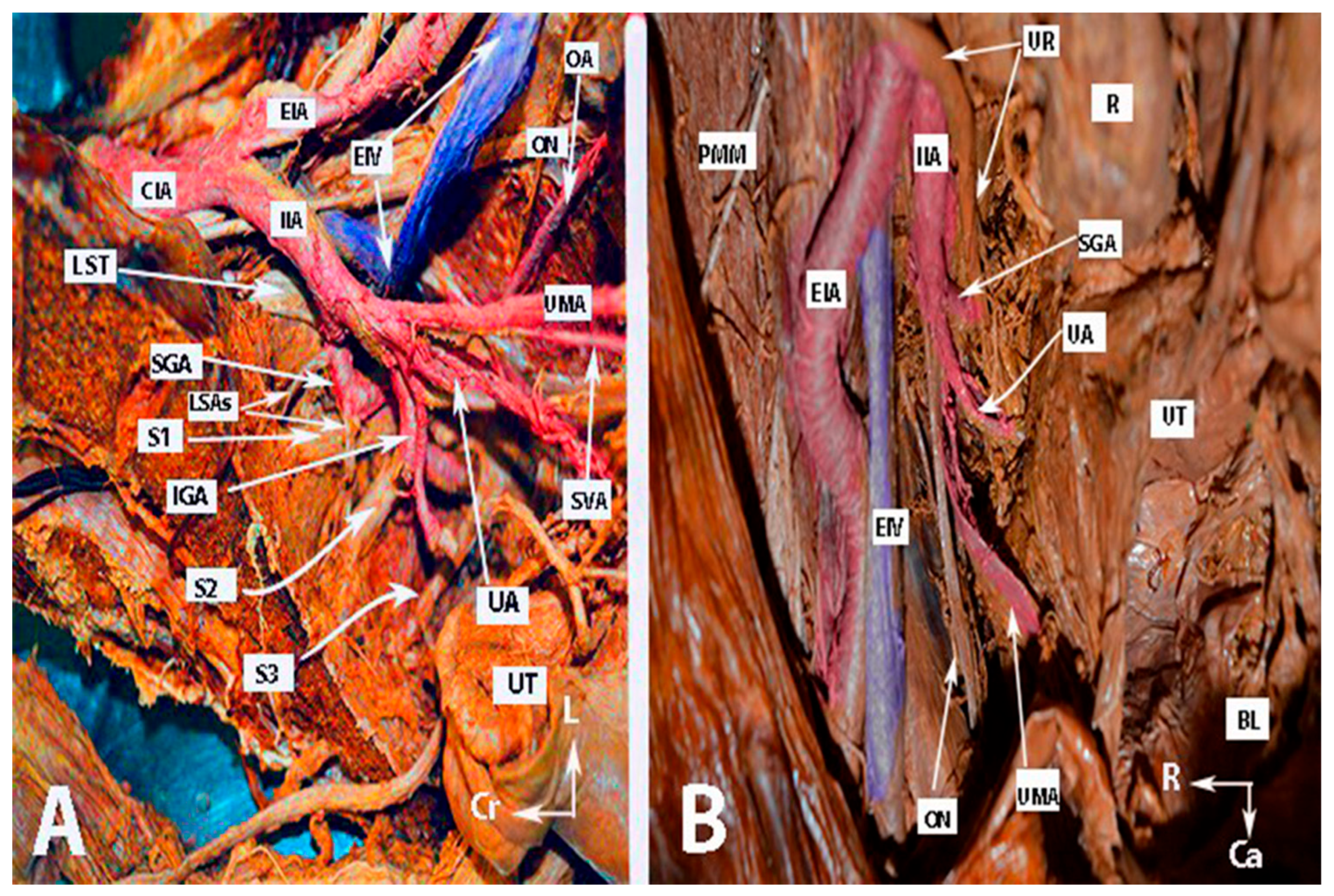
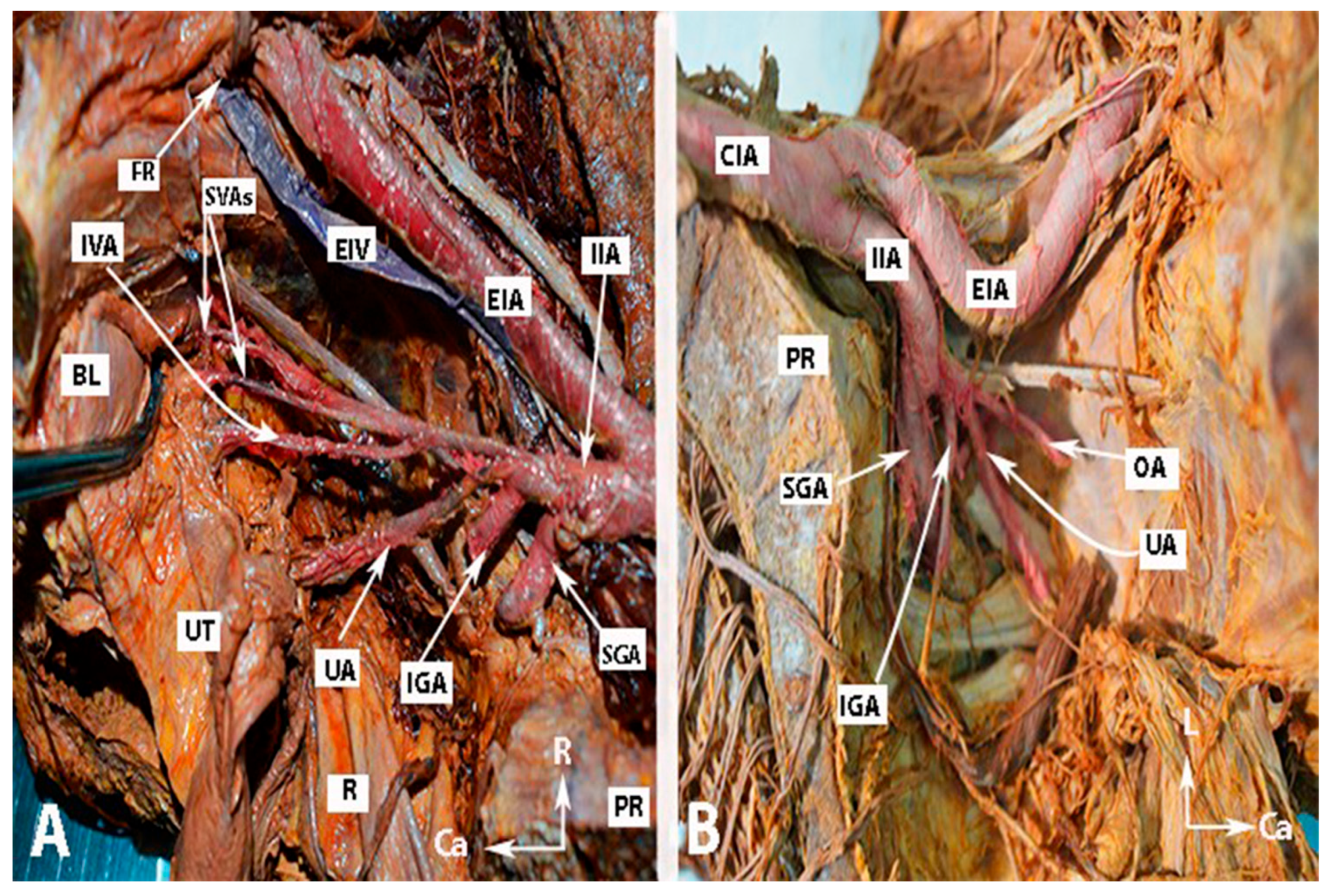
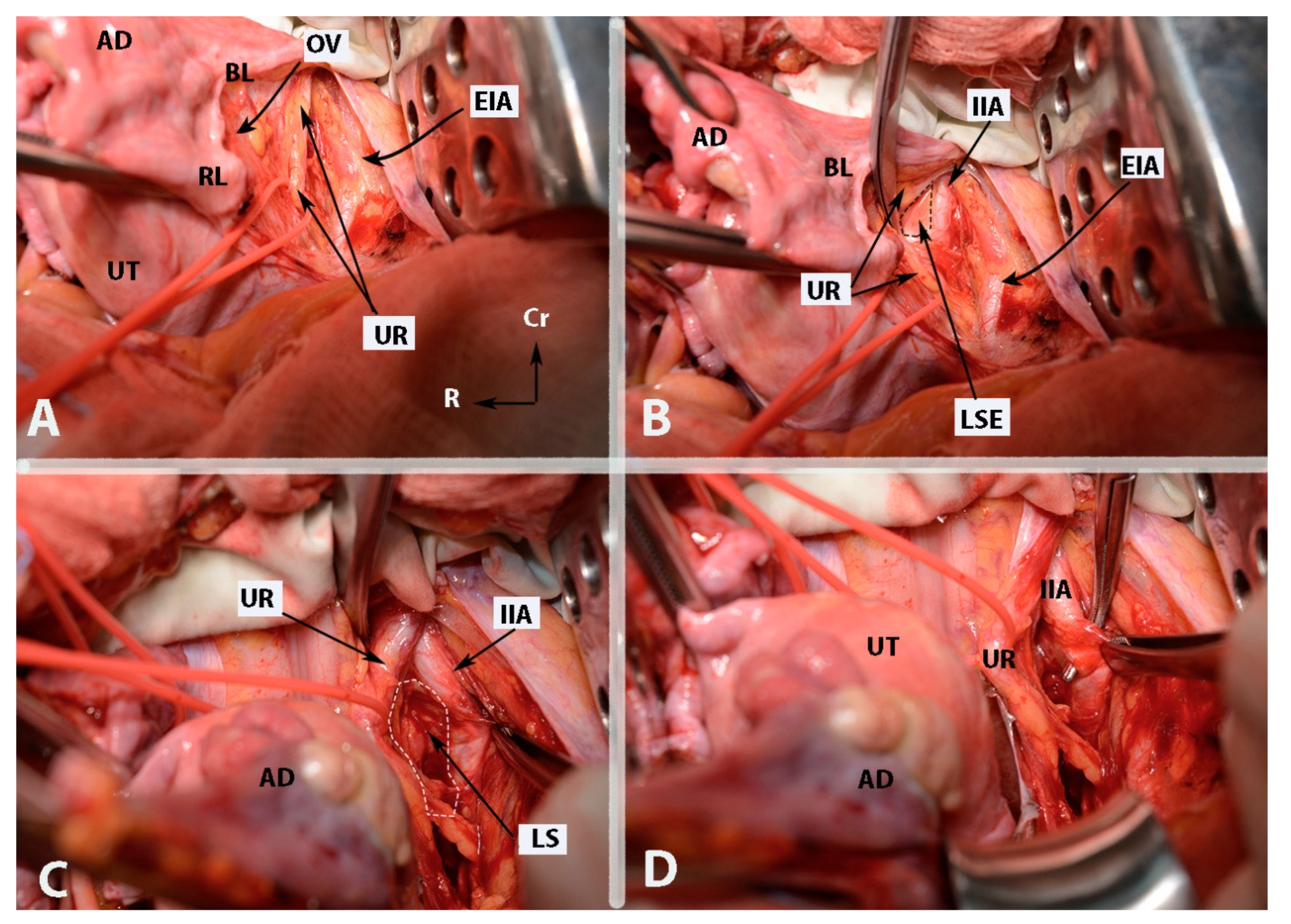
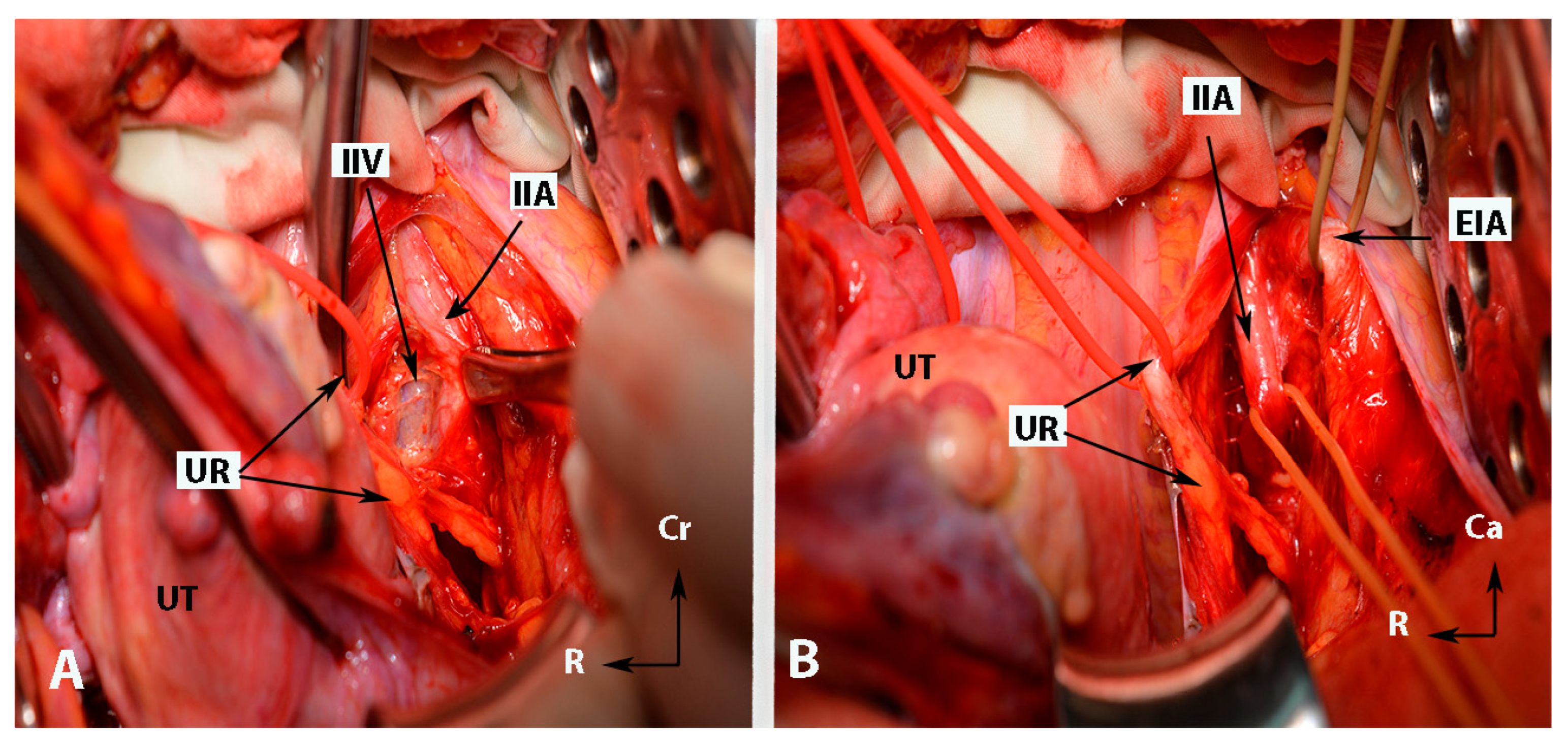
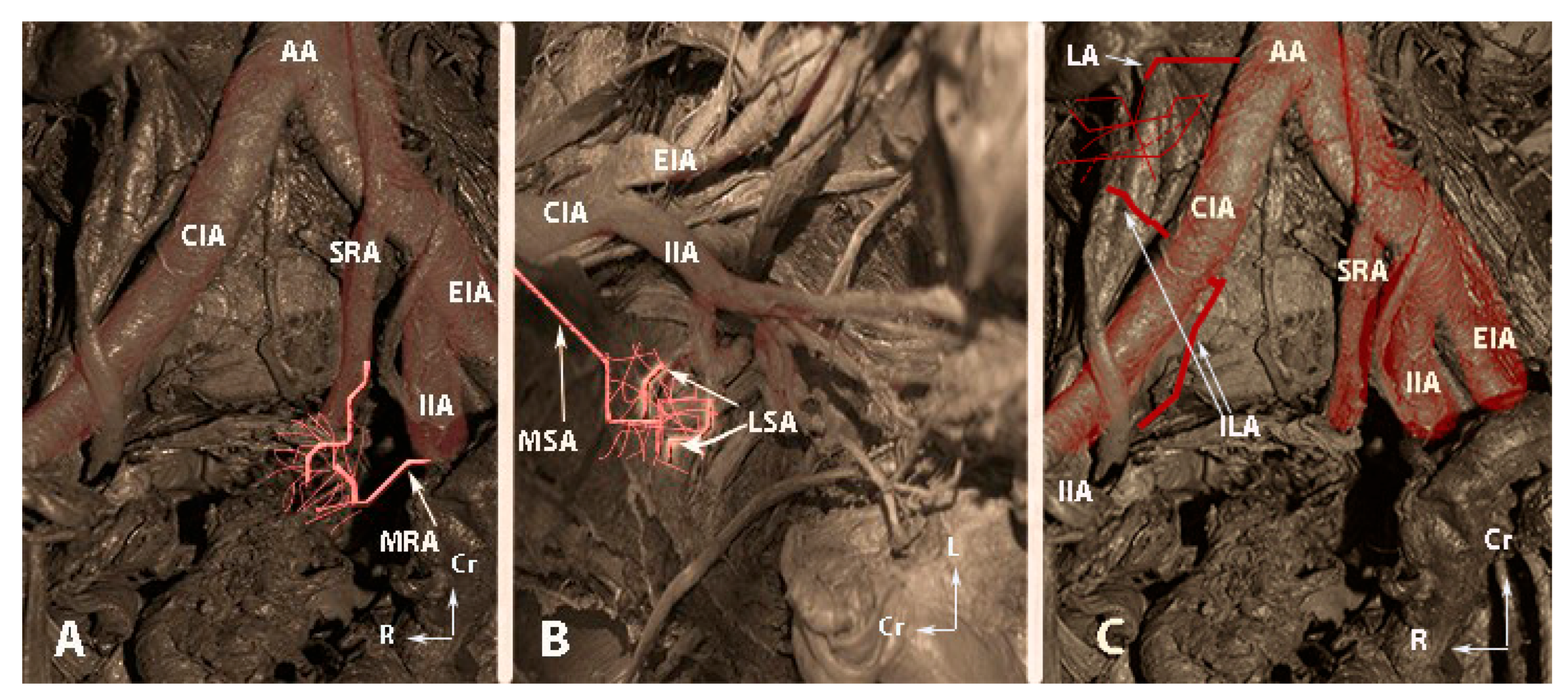


| Author | Year | Cadaver Origin | Number of Cadavers or Hemi-Pelvises | Mean Length (cm) (±SD) | Range (cm) |
|---|---|---|---|---|---|
| Adachi [19] | 1928 | Japan | 121 | 44.3 (±1.3) | |
| Shafiroff et al. [13] | 1959 | USA | 150 | 1–3 (21%) 3–5 (60%) 5–7 (13%) | |
| Fatu et al. [20] | 2006 | Romania | 100 | 4.9 | 2–9 |
| Bleich et al. [18] | 2007 | USA | 54 (right) 54 (left) | 26.8 27 | 0–5.2 0–4.9 |
| Naveen [14] | 2011 | India | 60 (hemi-pelvises) | 3.7 (±4.62) | 1.3–5.4 |
| Sakthivelavan et al. [16] | 2014 | India | 58 | 3.7 | 2.3–7.1 |
| Yuvaraj et al. [21] | 2018 | India | 80 (right) 80 (left) | 3.94 (±0.86) 3.61 (±0.63) | 2.4–5.4 2.7–4.7 |
| Left IIA | Right IIA | |
|---|---|---|
| Anterior | Parietal peritoneum | Ureter attached to the parietal peritoneum |
| Posterolateral | External iliac vein, obturator nerve | External iliac vein, obturator nerve |
| Posteromedial | Internal iliac vein | Internal iliac vein |
| Lateral | Psoas major muscle | Psoas major muscle |
| Medial | Ureter | Parietal peritoneum |
Disclaimer/Publisher’s Note: The statements, opinions and data contained in all publications are solely those of the individual author(s) and contributor(s) and not of MDPI and/or the editor(s). MDPI and/or the editor(s) disclaim responsibility for any injury to people or property resulting from any ideas, methods, instructions or products referred to in the content. |
© 2023 by the authors. Licensee MDPI, Basel, Switzerland. This article is an open access article distributed under the terms and conditions of the Creative Commons Attribution (CC BY) license (https://creativecommons.org/licenses/by/4.0/).
Share and Cite
Kostov, S.; Kornovski, Y.; Watrowski, R.; Slavchev, S.; Ivanova, Y.; Yordanov, A. Internal Iliac Artery Ligation in Obstetrics and Gynecology: Surgical Anatomy and Surgical Considerations. Clin. Pract. 2024, 14, 32-51. https://doi.org/10.3390/clinpract14010005
Kostov S, Kornovski Y, Watrowski R, Slavchev S, Ivanova Y, Yordanov A. Internal Iliac Artery Ligation in Obstetrics and Gynecology: Surgical Anatomy and Surgical Considerations. Clinics and Practice. 2024; 14(1):32-51. https://doi.org/10.3390/clinpract14010005
Chicago/Turabian StyleKostov, Stoyan, Yavor Kornovski, Rafał Watrowski, Stanislav Slavchev, Yonka Ivanova, and Angel Yordanov. 2024. "Internal Iliac Artery Ligation in Obstetrics and Gynecology: Surgical Anatomy and Surgical Considerations" Clinics and Practice 14, no. 1: 32-51. https://doi.org/10.3390/clinpract14010005
APA StyleKostov, S., Kornovski, Y., Watrowski, R., Slavchev, S., Ivanova, Y., & Yordanov, A. (2024). Internal Iliac Artery Ligation in Obstetrics and Gynecology: Surgical Anatomy and Surgical Considerations. Clinics and Practice, 14(1), 32-51. https://doi.org/10.3390/clinpract14010005









